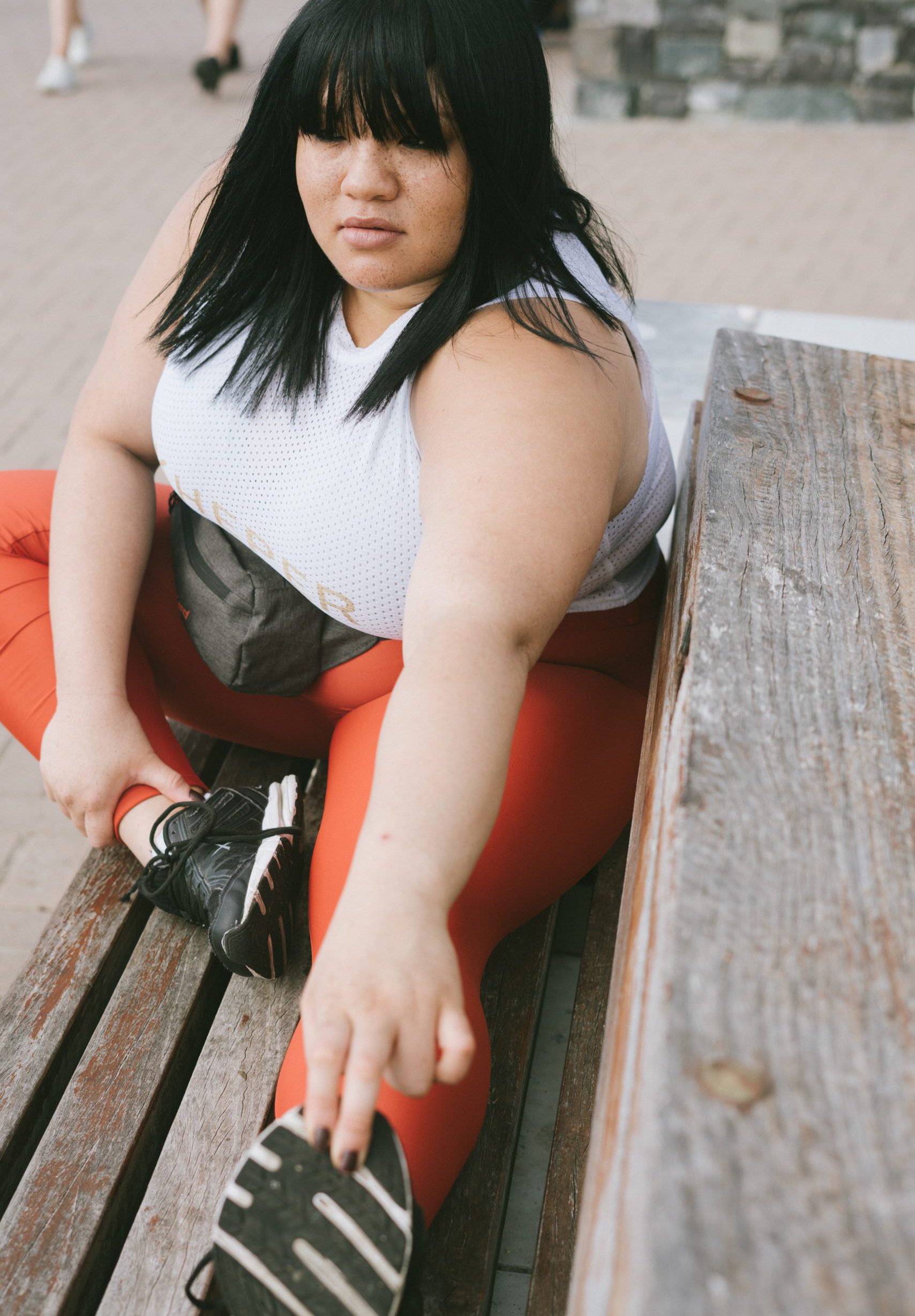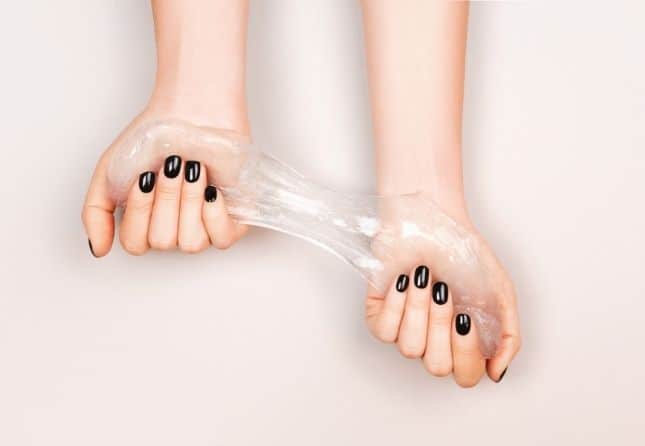Home > Female Body > Menstrual cycle > Exercise and your Menstrual cycle: How Estrogen affects muscles


Gang, it’s time we talk about Estrogen’s other jobs. Yes, it’s vital in reproduction, but it’s also vital to just a bunch of other stuff. And one of those things is working out. More specifically, your muscles and endurance level. Welcome to exercise and your Menstrual cycle. It’s a whole new world. And one you can use to your advantage…
If you’re Premenopausal in any fashion, it’s mostly produced in your ovaries. For everyone else, Estrogen comes from fat cells and your adrenal glands, but in much smaller quantities.
Estrogen is essential if you have periods, as it’s responsible for growing your eggs once a month. And, as you’ll know if you’re a regular Hormona, your levels rise and fall depending on where you are in your cycle.
During the first half, or Follicular phase, of your cycle, levels slowly increase, before Ovulation when they drop. Then, during the Luteal phase, Estrogen increases again. Here’s a handy little graphic of how your Estrogen behaves during the month.
When we’re talking about exercise and your menstrual cycle, we’re really talking about Estrogen. More specifically, how it affects your muscles, tendons, and ligaments.
If you didn’t study anatomy at school, and most of us didn’t, here’s how that breaks down. Tendons attach your muscles to your bones, while ligaments connect bones to bones where they join. With us so far?
Ligaments should be stiff, as that generally means you’ve got stable joints and get fewer joint injuries. Tendons, though, are more subtle. Stiff tendons are a generally good thing, as they can increase your strength and speed. However, if they’re too stiff, that can cause muscle strain and raise the likelihood of injury.
And wouldn’t you know it, the changes in hormone levels throughout your Menstrual cycle, and throughout your life, can affect how vulnerable you are to injury.
So, where exercise and your Menstrual cycle are concerned, higher Estrogen increases the strength of your muscles. Which is great. But, it can also make your ligaments and tendons a little wobbly. Which can be less great. Who knew?
There’s a good chance you’ve heard that Testosterone is how you increase muscle mass and strength. This can happen naturally, with exercise and the like, or with external help, including steroids.
While that is true, there’s also some evidence that Estrogen can improve your ability to build muscle mass. But it doesn’t stop there. It can also help increase strength and how long you can go full-tilt before falling down.
Now, this research compared Pre and Postmenopausal women, rather than women during different phases of their cycle. The implication though, is that when your Estrogen is highest, during the mid-point of your cycle, you might be getting just a little bit more from your workouts.
As with all things hormones, any imbalance can have health consequences. And where Estrogen is concerned, not having enough can lead to a loss of muscle mass and strength, as well as bone density. And it can mean you take longer to heal after an injury.
Low Estrogen is mostly a concern after, you guessed it, Menopause. Once your ovaries stop producing the hormone every month, your levels drop to an all-time low. And that’s why Postmenopausal women can have more fragile bones, lower strength levels, and longer recovery times.
But, if you’ve had a hysterectomy that also involved your ovaries, or have a Thyroid condition, your levels can also drop. And that leaves you open to all of those low muscle and strength-related issues.
Believe it or not, higher Estrogen levels can help reduce the inflammation in your muscles after exercise. And it could even help improve the way your muscles regenerate after a muscle injury, meaning you heal faster. Which might be why women tend to have fewer muscle injuries than men. Not too shabs, right?
As we said earlier, ligaments and tendons are slightly different. Where your muscles are less prone to injury, your tendons and ligaments are far more likely to suffer.
In fact, people with periods, as opposed to men or Postmenopausal women, are more likely to rupture their knee’s Anterior Cruciate Ligament, or ACL, in general. Stiff ligaments are generally, a good thing, but Estrogen can make them too stiff, leading to injury. Add in the higher Estrogen levels that appear around ovulation, and the risk of ACL injury increases again.
But where tendons are concerned, high Estrogen actually decreases their stiffness. And because stiffer tendons are associated with less muscle injury, those levels can reduce the risk of muscle injury, thanks to your more flexible tendons. That said, if your levels get too high, that’s a very bad thing for your tendons. And yes, it’s very confusing.
Women are also less likely to rupture their Achilles tendon, the big, rubbery tendon at the back of your ankle, than men. That is, until Menopause, when Estrogen levels drop. After which, the risk of Achilles tendon rupture is the same for both men and women.
As with muscle mass and strength, those with Thyroid issues, post-hysterectomy or Postmenopausal are liable to increased muscle injury, decreased bone mass, and longer healing times. But, your tendons will also be less flexible and your ligaments looser. So, it’s all a bit of a mess. Be careful.
Now, it’s going to get a bit muddled here, so bear with us. Regular Hormonas will be well aware of the medical profession’s, ahem, reluctance, to study women’s things in any fashion, so the research in this area is scant and the evidence confusing. But here goes.
Birth control pills with high levels of Progesterone can have a negative impact on muscle. But, they might also protect you against ligament injuries, including the aforementioned ACL rupture.
There’s also evidence that, by keeping your Estrogen levels fairly constant with the pill, your risk of ACL rupture is smaller versus your natural hormone cycle. With us so far?
That said, because taking the pill balances out your cycle’s natural hormone fluctuations, it could also increase your risk of tendon injuries. Believe it or not, women taking birth control pills have higher rates of muscle and tendon injuries than women who don’t take them.
But, there is one incredible benefit to having a ton of Estrogen. Did you know that it has anti-inflammatory properties? And even better, did you know that you can use that to your advantage?
Inflammation, or swelling, is part of your body’s natural response to injury or infection. Despite the pain often associated with it, inflammation is actually part of the healing process. It helps coordinate all the cells and chemical messengers that are necessary to heal after infection or injury.
Sometimes, though, your body can overdo the inflammation, or activate the response in an inappropriate way. And this can often be the case with Auto-immune conditions, where your own cells are seen as invaders. Excessive or prolonged inflammation is also involved in a lot of chronic diseases, including metabolic syndrome.
Anti-inflammatory compounds are those that, perhaps unsurprisingly, reduce inflammation. And, this one might floor you, but your body actually produces its own anti-inflammatories to deal with pain and swelling.
The levels aren’t always adequate, though, so sciencey types came up with another way to deal with the pain: Ibuprofen and the like are known as Non-Steroidal Anti-Inflammatory Drugs, or NSAIDs. And if you’re someone who lives with cramps once a month, you’re probably already very familiar with them.
But here’s the thing. Estrogen is already well-known for its ability to decrease inflammation caused by illness or injury. So if you’re going to get sick, do it around ovulation, right? These anti-inflammatory properties, though, can also be applied to your muscles in the context of exercise.
Estrogen is highest during the second half of the Follicular phase, the mid-pointish of your cycle, lowering inflammation. Which means that you’re less likely to experience DOMS, or Delayed Onset Muscle Soreness, after you’ve exercised on those days.
Here is where it gets interesting. Thanks to the higher Estrogen levels around ovulation, you’re more likely to build muscle mass if you’re into strength training and workout on those days.
Plus, high Estrogen can lower the likelihood of muscle injury, thanks to all that anti-inflammatory stuff its got going on, and its positive effect on your tendons. And as if that wasn’t enough, higher Estrogen can also help you heal faster if you do happen to get injured.
And how can you use this to your advantage? Where exercise and your Menstrual cycle are concerned, planning and tailoring your workouts according to where you are can have a huge impact on your endurance and effectiveness. And you could even avoid injury if you time it right.
The best way to do that? Shameless plug time! Get yourself on the Hormona app — you can track your cycle and symptoms, so you’ll know well ahead of time when ovulation is approaching. But you’ll also know when to take it down a notch, say, during the run-up to your period.
And remember, very high Estrogen can actually increase the risk of ligament injuries, so be careful out there. Also, look after your knees.
Disclaimer: This website does not provide medical advice. The information, including but not limited to, text, graphics, images and other material contained on this website are for informational purposes only. No material on this site is intended to be a substitute for professional medical advice, diagnosis, or treatment. Always seek the advice of your physician or other qualified healthcare provider with any questions you may have regarding a medical condition or treatment, and before undertaking a new health care regimen, and never disregard professional medical advice or delay in seeking it because of something you have read on this website.

-


Dr Singh is the Medical Director of the Indiana Sleep Center. His research and clinical practice focuses on the myriad of sleep.

What vaginal discharge colors mean for your health Understanding vaginal discharge colors and meaning is essential for every woman at every stage of life. While some colored discharge may indicate infections, others are normal. White and clear The first discharge

Understanding perimenopause and menopause When talking about perimenopause versus menopause, it’s easy to confuse these two stages. Perimenopause is the transitional period when you move away from your peak fertility and your ovaries gradually stop releasing eggs. In turn, menstruation

Understanding perimenopause and its symptoms When it comes to aging, many women know about menopause but are surprised to learn about the transitional stage leading up to it, called perimenopause. There are three stages of perimenopause: early, late, and menopause,
| Cookie | Duration | Description |
|---|---|---|
| cookielawinfo-checkbox-analytics | 11 months | This cookie is set by GDPR Cookie Consent plugin. The cookie is used to store the user consent for the cookies in the category "Analytics". |
| cookielawinfo-checkbox-functional | 11 months | The cookie is set by GDPR cookie consent to record the user consent for the cookies in the category "Functional". |
| cookielawinfo-checkbox-necessary | 11 months | This cookie is set by GDPR Cookie Consent plugin. The cookies is used to store the user consent for the cookies in the category "Necessary". |
| cookielawinfo-checkbox-others | 11 months | This cookie is set by GDPR Cookie Consent plugin. The cookie is used to store the user consent for the cookies in the category "Other. |
| cookielawinfo-checkbox-performance | 11 months | This cookie is set by GDPR Cookie Consent plugin. The cookie is used to store the user consent for the cookies in the category "Performance". |
| viewed_cookie_policy | 11 months | The cookie is set by the GDPR Cookie Consent plugin and is used to store whether or not user has consented to the use of cookies. It does not store any personal data. |
